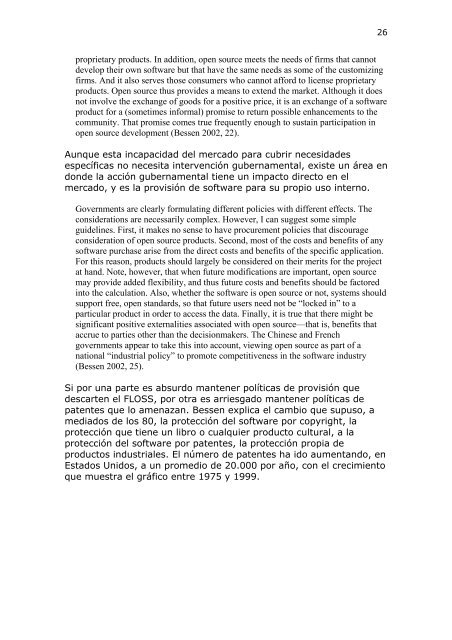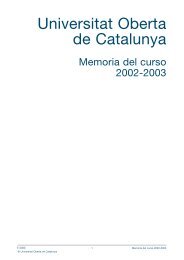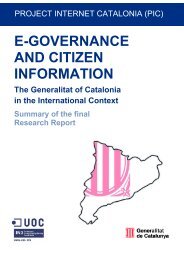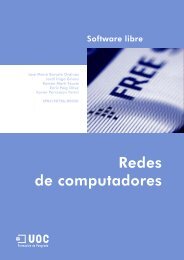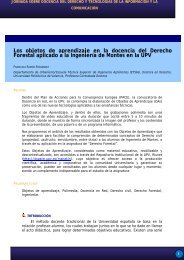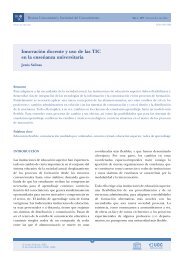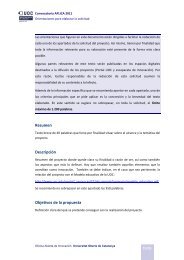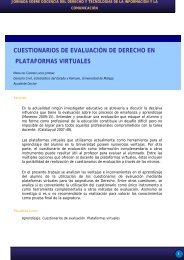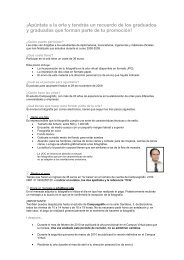El uso del software libre en las administraciones públicas de la UE
El uso del software libre en las administraciones públicas de la UE
El uso del software libre en las administraciones públicas de la UE
Create successful ePaper yourself
Turn your PDF publications into a flip-book with our unique Google optimized e-Paper software.
26proprietary products. In addition, op<strong>en</strong> source meets the needs of firms that cannot<strong>de</strong>velop their own <strong>software</strong> but that have the same needs as some of the customizingfirms. And it also serves those consumers who cannot afford to lic<strong>en</strong>se proprietaryproducts. Op<strong>en</strong> source thus provi<strong>de</strong>s a means to ext<strong>en</strong>d the market. Although it doesnot involve the exchange of goods for a positive price, it is an exchange of a <strong>software</strong>product for a (sometimes informal) promise to return possible <strong>en</strong>hancem<strong>en</strong>ts to thecommunity. That promise comes true frequ<strong>en</strong>tly <strong>en</strong>ough to sustain participation inop<strong>en</strong> source <strong>de</strong>velopm<strong>en</strong>t (Bess<strong>en</strong> 2002, 22).Aunque esta incapacidad <strong><strong>de</strong>l</strong> mercado para cubrir necesida<strong>de</strong>sespecíficas no necesita interv<strong>en</strong>ción gubernam<strong>en</strong>tal, existe un área <strong>en</strong>don<strong>de</strong> <strong>la</strong> acción gubernam<strong>en</strong>tal ti<strong>en</strong>e un impacto directo <strong>en</strong> elmercado, y es <strong>la</strong> provisión <strong>de</strong> <strong>software</strong> para su propio <strong>uso</strong> interno.Governm<strong>en</strong>ts are clearly formu<strong>la</strong>ting differ<strong>en</strong>t policies with differ<strong>en</strong>t effects. Theconsi<strong>de</strong>rations are necessarily complex. However, I can suggest some simplegui<strong><strong>de</strong>l</strong>ines. First, it makes no s<strong>en</strong>se to have procurem<strong>en</strong>t policies that discourageconsi<strong>de</strong>ration of op<strong>en</strong> source products. Second, most of the costs and b<strong>en</strong>efits of any<strong>software</strong> purchase arise from the direct costs and b<strong>en</strong>efits of the specific application.For this reason, products should <strong>la</strong>rgely be consi<strong>de</strong>red on their merits for the projectat hand. Note, however, that wh<strong>en</strong> future modifications are important, op<strong>en</strong> sourcemay provi<strong>de</strong> ad<strong>de</strong>d flexibility, and thus future costs and b<strong>en</strong>efits should be factoredinto the calcu<strong>la</strong>tion. Also, whether the <strong>software</strong> is op<strong>en</strong> source or not, systems shouldsupport free, op<strong>en</strong> standards, so that future users need not be “locked in” to aparticu<strong>la</strong>r product in or<strong>de</strong>r to access the data. Finally, it is true that there might besignificant positive externalities associated with op<strong>en</strong> source—that is, b<strong>en</strong>efits thataccrue to parties other than the <strong>de</strong>cisionmakers. The Chinese and Fr<strong>en</strong>chgovernm<strong>en</strong>ts appear to take this into account, viewing op<strong>en</strong> source as part of anational “industrial policy” to promote competitiv<strong>en</strong>ess in the <strong>software</strong> industry(Bess<strong>en</strong> 2002, 25).Si por una parte es absurdo mant<strong>en</strong>er políticas <strong>de</strong> provisión que<strong>de</strong>scart<strong>en</strong> el FLOSS, por otra es arriesgado mant<strong>en</strong>er políticas <strong>de</strong>pat<strong>en</strong>tes que lo am<strong>en</strong>azan. Bess<strong>en</strong> explica el cambio que sup<strong>uso</strong>, amediados <strong>de</strong> los 80, <strong>la</strong> protección <strong><strong>de</strong>l</strong> <strong>software</strong> por copyright, <strong>la</strong>protección que ti<strong>en</strong>e un libro o cualquier producto cultural, a <strong>la</strong>protección <strong><strong>de</strong>l</strong> <strong>software</strong> por pat<strong>en</strong>tes, <strong>la</strong> protección propia <strong>de</strong>productos industriales. <strong>El</strong> número <strong>de</strong> pat<strong>en</strong>tes ha ido aum<strong>en</strong>tando, <strong>en</strong>Estados Unidos, a un promedio <strong>de</strong> 20.000 por año, con el crecimi<strong>en</strong>toque muestra el gráfico <strong>en</strong>tre 1975 y 1999.


